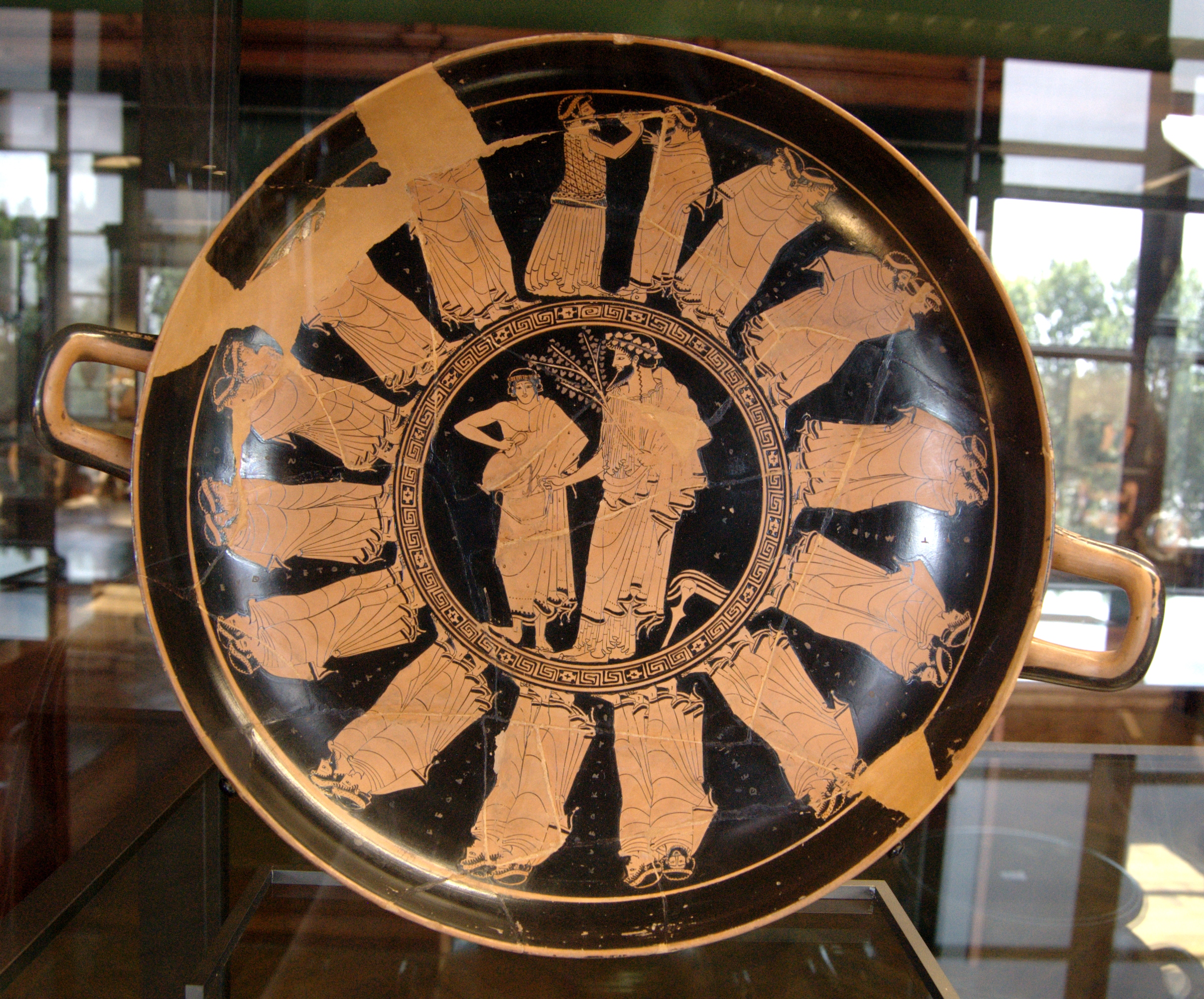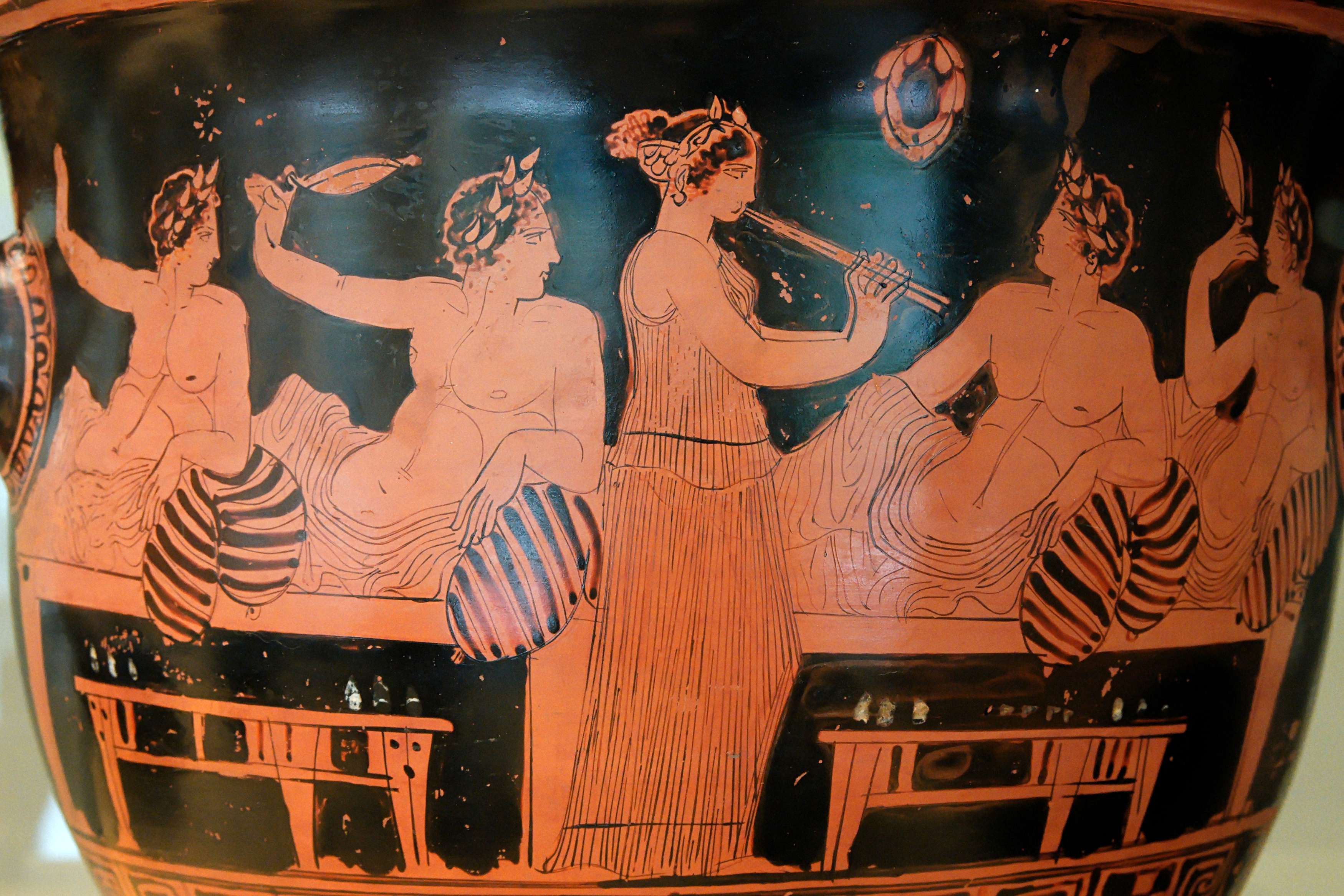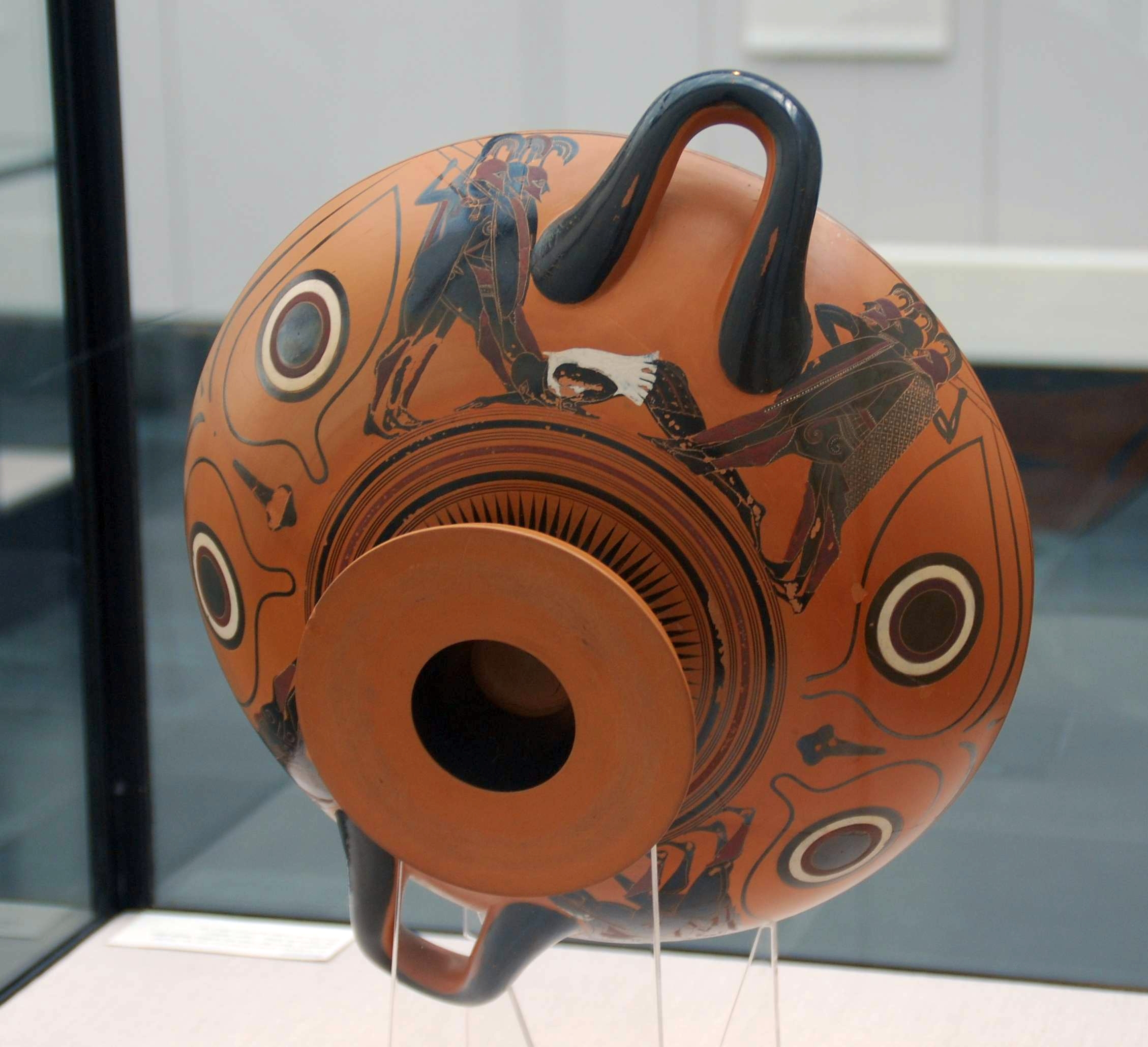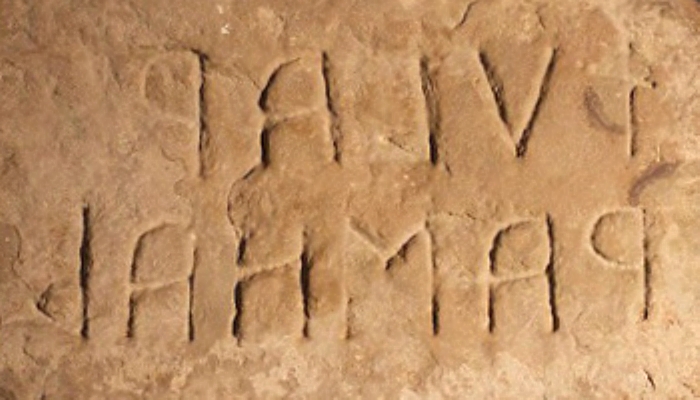|
Kylix
In the pottery of ancient Greece, a kylix ( , ; ; also spelled ''cylix''; : kylikes , ) is the most common type of cup in the period, usually associated with the drinking of wine. The cup often consists of a rounded base and a thin stem under a basin. The cup is accompanied by two handles on opposite sides. The inner basin is often adorned in the bottom so that as the liquid is consumed an image is revealed; this adornment is usually in a circular frame and called a tondo. There are many variations of the kylikes, other cups available in the era include the skyphos, or the kantharoi. Kylikes were also popular exports, being the most common pottery import from Attica found in Etruscan settlements. Etymology The Greek word ''kylix'', meaning 'cup', could refer to both a drinking vessel as well as the cup shape of a flower. It is possibly related to the Latin word ''calix'', also meaning 'cup', and may have originally been borrowed from a non-Indo-European language. Kylix a ... [...More Info...] [...Related Items...] OR: [Wikipedia] [Google] [Baidu] |
Symposium Scene Nicias Painter MAN
In Ancient Greece, the symposium (, ''sympósion'', from συμπίνειν, ''sympínein'', 'to drink together') was the part of a banquet that took place after the meal, when drinking for pleasure was accompanied by music, dancing, recitals, or conversation.Peter Garnsey, ''Food and Society in Classical Antiquity'' (Cambridge University Press, 1999), p. 13online Sara Elise Phang, ''Roman Military Service: Ideologies of Discipline in the Late Republic and Early Principate'' (Cambridge University Press, 2008), pp. 263–264. Literary works that describe or take place at a symposium include two Socratic dialogues, Plato's ''Symposium (Plato), Symposium'' and Xenophon's ''Symposium (Xenophon), Symposium'', as well as a number of ancient Greek literature, Greek poems, such as the elegiac couplet, elegies of Theognis of Megara. Symposia are depicted in Ancient Greek art, Greek and Etruscan art that shows similar scenes. In modern usage, it has come to mean an academic conference or m ... [...More Info...] [...Related Items...] OR: [Wikipedia] [Google] [Baidu] |
Red-figure Pottery
Red-figure pottery () is a style of Pottery of ancient Greece, ancient Greek pottery in which the background of the pottery is painted black while the figures and details are left in the natural red or orange color of the clay. It developed in Athens around 520 BC and remained in use until the late 3rd century AD. It replaced the previously dominant style of black-figure pottery within a few decades. Its modern name is based on the figural depictions in red color on a black background, in contrast to the preceding black-figure style with black figures on a red background. The most important areas of production, apart from Attica, were in Magna Graecia, Southern Italy. The style was also adopted in other parts of Greece. Etruria became an important center of production outside the Ancient Greece, Greek World. Attic red-figure vases were exported throughout Greece and beyond. For a long time, they dominated the market for fine ceramics. Few centers of pottery production could compe ... [...More Info...] [...Related Items...] OR: [Wikipedia] [Google] [Baidu] |
Symposium
In Ancient Greece, the symposium (, ''sympósion'', from συμπίνειν, ''sympínein'', 'to drink together') was the part of a banquet that took place after the meal, when drinking for pleasure was accompanied by music, dancing, recitals, or conversation.Peter Garnsey, ''Food and Society in Classical Antiquity'' (Cambridge University Press, 1999), p. 13online Sara Elise Phang, ''Roman Military Service: Ideologies of Discipline in the Late Republic and Early Principate'' (Cambridge University Press, 2008), pp. 263–264. Literary works that describe or take place at a symposium include two Socratic dialogues, Plato's '' Symposium'' and Xenophon's '' Symposium'', as well as a number of Greek poems, such as the elegies of Theognis of Megara. Symposia are depicted in Greek and Etruscan art that shows similar scenes. In modern usage, it has come to mean an academic conference or meeting, such as a scientific conference. The Latin equivalent of a Greek symposium in Roman s ... [...More Info...] [...Related Items...] OR: [Wikipedia] [Google] [Baidu] |
Eye-cup
Eye-cup is the term describing a specific cup type in ancient Greek pottery, distinguished by pairs of eyes painted on the external surface. Description Classified as ''kylix (drinking cup), kylikes'' in terms of shape, eye-cups were especially widespread in Athens and Chalkis in the second half of the sixth century BC. The bowl of the eye-cup rests on a short squat foot; both sides are dominated by large painted pairs of eyes under arched eyebrows. The eyeballs are painted in silhouette style, later often filled with white paint or painted white on black. Some eyes are "female", i.e. almond-shaped and without tear-ducts. Often, a stylized nose is placed centrally between the eyes. While used as a drinking vessel, due to the necessary inclination of the vessel, the cup with its painted eyes, the handles looking like ears and the base of the foot like a mouth, would have resembled a mask. Many of the vases also bear Dionysos, dionysiac imagery. The eyes are assumed to have se ... [...More Info...] [...Related Items...] OR: [Wikipedia] [Google] [Baidu] |
Pottery Of Ancient Greece
Pottery, due to its relative durability, comprises a large part of the archaeological record of ancient Greece, and since there is so much of it (over 100,000 painted vases are recorded in the Corpus vasorum antiquorum), it has exerted a disproportionately large influence on our understanding of Greek Society#Politics and society, Greek society. The shards of pots discarded or buried in the 1st millennium BC are still the best guide available to understand the customary life and mind of the ancient Greeks. There were several vessels produced locally for everyday and kitchen use, yet finer pottery from regions such as Attica was imported by other civilizations throughout History of the Mediterranean, the Mediterranean, such as the Etruscan civilization, Etruscans in Italy.John H. Oakley (2012). "Greek Art and Architecture, Classical: Classical Greek Pottery," in Neil Asher Silberman et al. (eds), ''The Oxford Companion to Archaeology, Vol 1: Ache-Hoho'', 2nd Edition, 641–644. O ... [...More Info...] [...Related Items...] OR: [Wikipedia] [Google] [Baidu] |
Kottabos
Kottabos () was a game of skill played at Ancient Greek and Etruscan symposia (drinking parties), especially in the 6th and 5th centuries BC. It involved flinging wine-lees (sediment) at a target in the middle of the room. The winner would receive a prize (κοττάβιον or "''kottabion''"), comprising cakes, sweetmeats, or kisses. Ancient writers, including Dionysius Chalcus, Alcaeus, Anacreon, Pindar, Bacchylides, Aeschylus, Sophocles, Euripides, Aristophanes, and Antiphanes, make frequent and familiar allusion to the practice; and it is depicted on contemporaneous red-figure vases. References to the practice by the writers of the Roman and Alexandrian periods show that the fashion had died out. In Latin literature, it is almost entirely unknown. Dexterity was required to succeed in the game, and unusual ability was rated as highly as corresponding excellence in throwing the javelin. Kottabos was customary, and, at least in Sicily, special circular buildings were est ... [...More Info...] [...Related Items...] OR: [Wikipedia] [Google] [Baidu] |
Merrythought Cup
The term Merrythought cup is used by scholars to describe a specific type of Attic ''kylix In the pottery of ancient Greece, a kylix ( , ; ; also spelled ''cylix''; : kylikes , ) is the most common type of cup in the period, usually associated with the drinking of wine. The cup often consists of a rounded base and a thin stem under ...''. The Merrythought cup, named after the British word for "wishbone," probably developed as a refined form of a rural cup type normally made of wood. The shape features several peculiarities. It is the first Attic cup shape that lacks a distinctive break between lip and vessel body. The shape of the handles, which give the vessel its name, are in the oblong wishbone shape, with a knob shape on the curve of the handle. Rather than forming a semi-circle, as is the case in virtual all other cup shapes. Equally unusual, the handles extend beyond the height of the vessel body. The cups, mostly covered in black slip, occasionally feature thin stripes ... [...More Info...] [...Related Items...] OR: [Wikipedia] [Google] [Baidu] |
Krater
A krater or crater (, ; , ) was a large two-handled type of vase in Pottery of ancient Greece, Ancient Greek pottery and metalwork, mostly used for the mixing of wine with water. Form and function At a Greek symposium, kraters were placed in the center of the room. They were quite large, so they were not easily portable when filled. Thus, the wine-water mixture would be withdrawn from the krater with other vessels, such as a (: ), an amphora (: ), or a (: ). In fact, Homer's ''Odyssey'' describes a steward drawing wine from a krater at a banquet and then running to and fro pouring the wine into guests' drinking cups. The modern Greek word now used for undiluted wine, (), originates from the (, ) of wine and water in kraters. Pottery kraters were ceramic glaze, glazed on the interior to make the surface of the clay more impervious for holding water, and possibly for aesthetic reasons, since the interior could easily be seen. The exterior of kraters often depicted scenes fro ... [...More Info...] [...Related Items...] OR: [Wikipedia] [Google] [Baidu] |
Etruscan Civilization
The Etruscan civilization ( ) was an ancient civilization created by the Etruscans, a people who inhabited Etruria in List of ancient peoples of Italy, ancient Italy, with a common language and culture, and formed a federation of city-states. After adjacent lands had been conquered its territory covered, at its greatest extent, roughly what is now Tuscany, western Umbria and northern Lazio, as well as what are now the Po Valley, Emilia-Romagna, south-eastern Lombardy, southern Veneto and western Campania. A large body of literature has flourished on the origins of the Etruscans, but the consensus among modern scholars is that the Etruscans were an indigenous population. The earliest evidence of a culture that is identifiably Etruscan dates from about 900 BC. This is the period of the Iron Age Villanovan culture, considered to be the earliest phase of Etruscan civilization, which itself developed from the previous late Bronze Age Proto-Villanovan culture in the same region, p ... [...More Info...] [...Related Items...] OR: [Wikipedia] [Google] [Baidu] |
Tondo (art)
A ''tondo'' (: ''tondi'' or ''tondos'') is a Renaissance term for a circular work of art, either a painting or a sculpture. The word derives from the Italian ''rotondo'', "round". The term is usually not used in English for small round paintings, but only those over about 60 cm (two feet) in diameter, thus excluding many round portrait miniatures – for sculpture the threshold is rather lower. A circular or oval relief sculpture is also called a roundel. The infrequently-encountered synonym rondoArtlex.com . usually refers to the musical form. History Artists have created ''tondi'' since antiquity. T ...[...More Info...] [...Related Items...] OR: [Wikipedia] [Google] [Baidu] |
Greek Language
Greek (, ; , ) is an Indo-European languages, Indo-European language, constituting an independent Hellenic languages, Hellenic branch within the Indo-European language family. It is native to Greece, Cyprus, Italy (in Calabria and Salento), southern Albania, and other regions of the Balkans, Caucasus, the Black Sea coast, Asia Minor, and the Eastern Mediterranean. It has the list of languages by first written accounts, longest documented history of any Indo-European language, spanning at least 3,400 years of written records. Its writing system is the Greek alphabet, which has been used for approximately 2,800 years; previously, Greek was recorded in writing systems such as Linear B and the Cypriot syllabary. The Greek language holds a very important place in the history of the Western world. Beginning with the epics of Homer, ancient Greek literature includes many works of lasting importance in the European canon. Greek is also the language in which many of the foundational texts ... [...More Info...] [...Related Items...] OR: [Wikipedia] [Google] [Baidu] |








